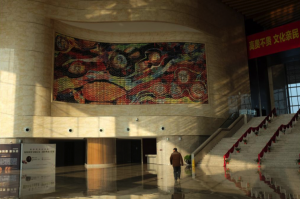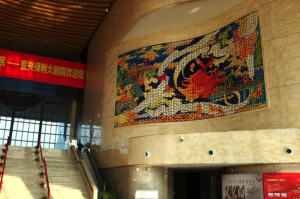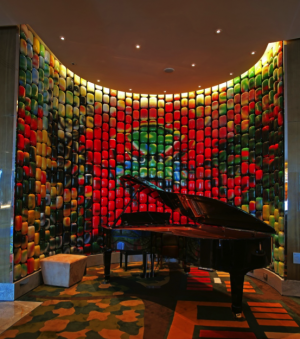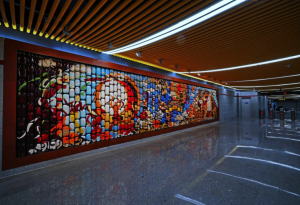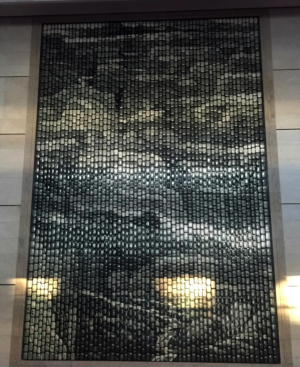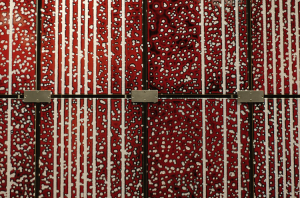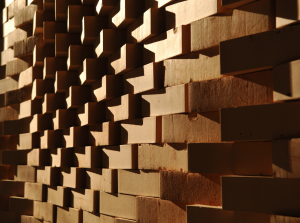Jiang Guoxing
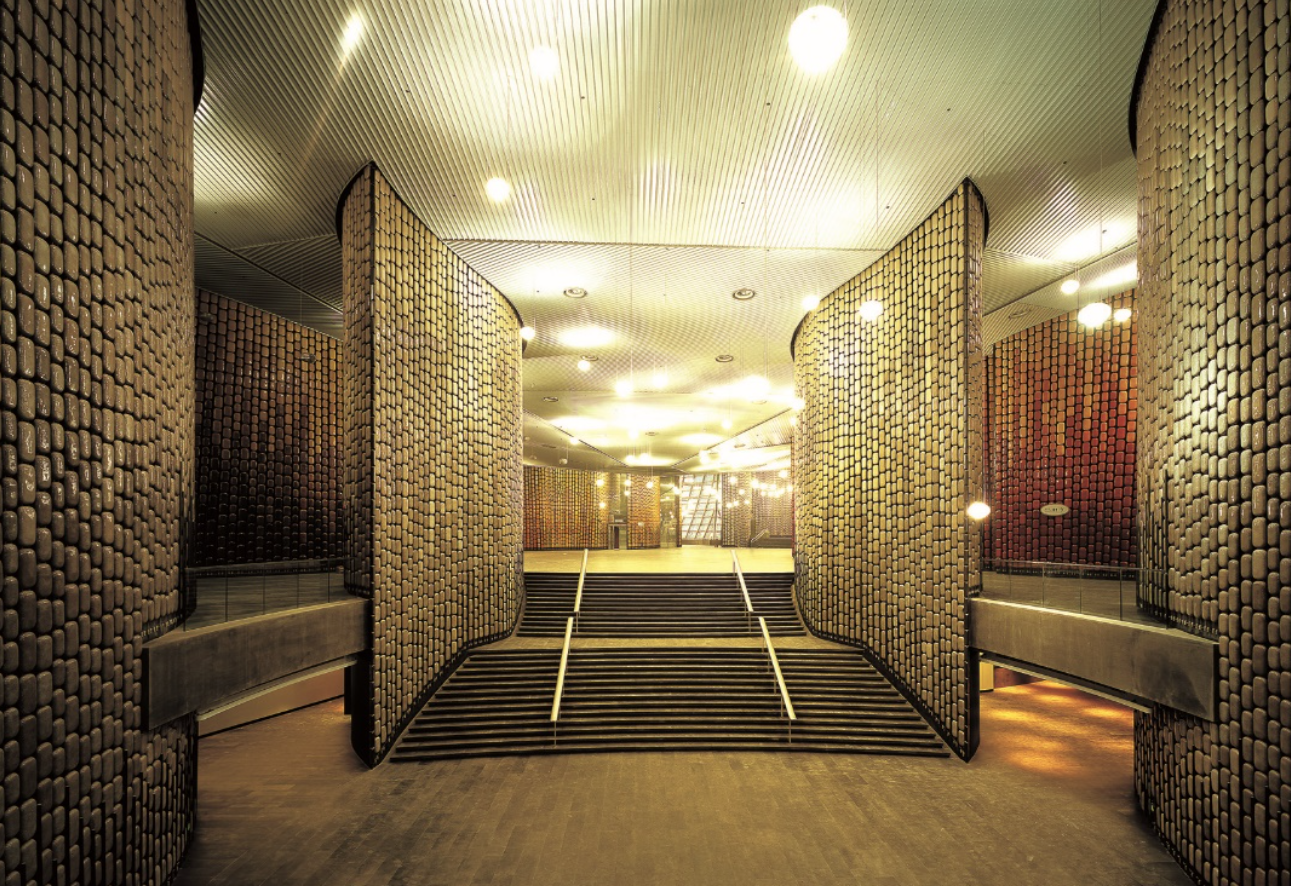 Colorful Flying Wings at Shanghai Oriental Art Center, Beijing |
|
THE SOUL OF CERAMICS INSTILLED INTO PUBLIC BUILDINGS |
||
|
Imagine ceramics implemented on the wall, that enables wide applications in architecture and public spaces. Yes, you can! Inspired by the Chinese traditional of purple clay couplets, the artist Jiang Guoxing creates a new ceramic landscape with an inventive technology and a unique aesthetic. His innovation? A metal structure that connects ceramic plates and building walls. We can speak of an emancipation of architectural ceramics allowing large scale applications. More, this ceramic artwork produces some unexpected artistic effects. Each single ceramic piece that composes the wall is a smooth oblong ceramic plate, with no right angle or sharp edge on its five sides! |
The colors are reflected in several directions. The artwork looks slightly different when you move around. It also absorbs indoor sounds and improves the acoustics of the building. It evokes a thick autonomous carpet, hung from the wall, bearing the iconography and the colors of China. With ceramic means, using a hanging method rather than glue, Jiang Guoxing produces an image composed of iconic patterns, at the scale of architecture. Created especially for AIC-IAC, he makes the point in his research and implementations. |
| Beijing Opera Symphony at Intercontinental Shanghai Expo Hotel is another large-scale wall hung ceramic artwork which carries forward Chinese culture. By creating a strong atmosphere of Chinese culture, it is an instant eye-popper at the grand hotel hall. Longhua Temple Bell and Drum at the hall of Longhua Temple Station, Shanghai Railway , newly finished Jiuguang Song and Butterfly Lovers Liang Shanbo and Zhu Yingtai at the hall of Poly Grand Theater in Yixing City, and Mountain Water Zen at the hall of Yixing Art Gallery are all creations which precisely capture the soul of the buildings by making sophisticated use of regional culture. |
|
|
Flying Wings at Shanghai Oriental Art Center The center is a well-known art building located in downtown Pudong District of Shanghai, covering nearly 40,000 square meters with the total investment of 1.1 billion RMB yuan. Its designer is Paul Andreu, a celebrated French architect who designed Charles de Gaulle Airport in Paris at 29. His works have been found throughout the world, including Beijing, where he designed the National Center for Performing Arts. He intended to highlight the charm of Chinese culture in his design of Shanghai Oriental Art Center. His inspiration came from the country’s past and future, aiming to present the atmosphere of authentic Oriental culture. In order to showcase a grand and splendid China and “very, very Chinese” elements, he hoped to use ceramic materials with Chinese characteristics as indoor decoration. He believed that ceramic art, in addition to its special quality and performance, is a gold mine of Chinese culture and an invitation the world cannot turn down. There was no other choice, in his mind. However, there was no precedent for introducing ceramic art into such a large-scale public building. |
> In June 2002, entrusted by the construction office of Shanghai Oriental Art Center, I headed the team responsible for pioneering research on wall hung ceramic artworks for indoor decoration. With an effort to produce a large-scale ceramic artwork with unique beauty and charm, we researched individually on special requirements for and construction difficulty in wall hung structures. Our research covered a wide range of topics, including raw materials, glaze, glazing technology, texture treatment, and on-site installation. In September 2014 when the installation project was completed, the artwork, named Colorful Flying Wings, was unveiled to the world, gorgeous and magnificent (Figure 11). It was appraised by Shanghai China Records Headquarters as the largest wall hung ceramic artwork for it consists of 127,102 plates, covers a total area of 11,000 square meters and wins 16 patents for invention issued by the State Intellectual Property Office of the P.R.C. It is a successful example for introduction of ceramic art into large-scale public architecture.
|
|
|
|
|
A profound social meaning Public architecture is endowed with profound social meaning and public awareness. In today’s world, public architecture covers buildings for almost all purposes except for residence, including for office, business, tourism, science, education, culture, health, telecommunications and traffic. Modern civilization expects these buildings not only to fulfill various functions but to play a distinctive role in spreading culture and serving as landmarks and role models, so that they may enhance the value of their own existence. In the context, ceramic art has its unique functional value and bright future in architecture and public spaces. China has a long history of applying ceramics to building decoration. Many of its royal palaces, temples and memorial halls have been richly decorated with ceramic elements in roofs, walls and corridors. |
To date, mass-production of ceramic bricks has enabled these elements to appear on all structures, indoor or outdoor. Traditionally, ceramic elements only serve as ornaments, which play a subsidiary role compared to main parts of the buildings. However, modern ceramic art may effectively integrate and communicate with various public buildings and endow them with a more profound and precise cultural meaning, thus enhancing their cultural contents and value of existence. This reminds us of wall hung art pieces, a Chinese traditional handicraft product which features wood, bamboo and paper as raw materials. They include artworks like couplets and calligraphies, hung on or clued to walls for indoor decoration and improved life quality. |
|
|
|
|
From purple clay teapots to Wall hung art pieces Can ceramics be turned into wall hung art pieces? Yes. This idea led to my first large-scale wall hung ceramic artwork. Within Zhejiang Province, China, stands Yixing City, named the Capital of Ceramics. The place, historically famous for its production of daily pottery ware, is now reputed for its purple clay culture, especially purple clay teapots. Traditionally, teapots with a scholar as one of their producers have been most appreciated. The scholar might inscribe some words or make a painting on the base of an unfired purple clay teapot produced by ceramic artisans, or might design the shape and pattern of a teapot, according to which the artisans produced the teapot. Such cooperation has lasted till now. Another common purple clay product is couplets made of purple clay plates. Scholars wrote one word on one ceramic plate, strung the plates with silk threads or hemp ropes, and hung the string in their halls. The couplets used to be the most important decoration in every household. They look dignified, prairie, elegant and ever-lasting and have high value of appreciation and collection, so they won great favor among royal families, high-ranking officials and the literati in Chinese history. My design team, inspired by the structure of these couplets, has begun to apply ceramic art to architecture and public spaces widely. The designers take advantage of highly plastic ceramic materials, wonderful glaze colors and modern metal connecting and fixing technology to string artistic ceramic plates into wall hung works. |
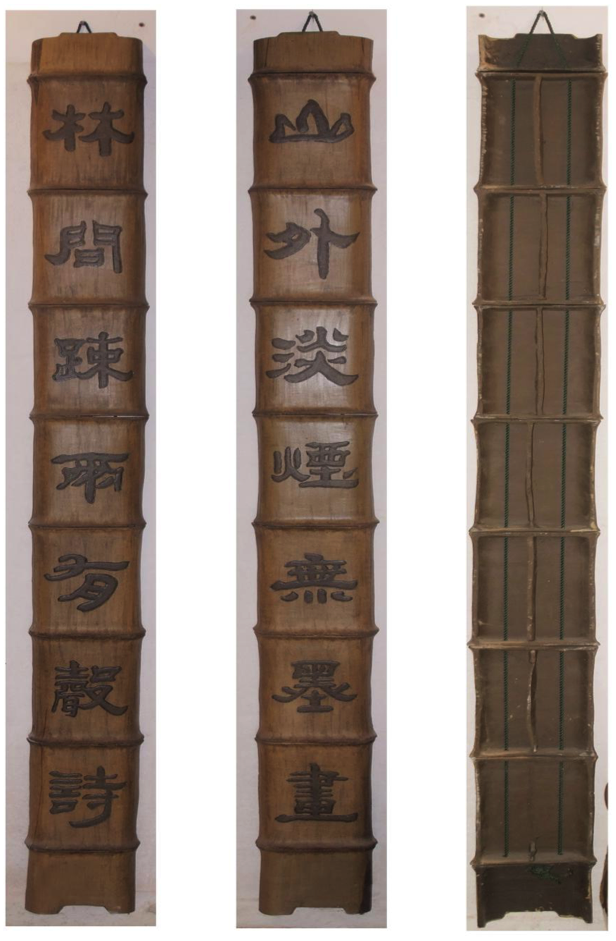 Chinese traditional purple clay couplets
The perfect combination of traditional ceramic art and modern metal fixtures is best exemplified by such large-scale wall hung ceramic works as Colorful Flying Wings at Shanghai Oriental Art Center and Beijing Opera Symphony at Intercontinental Shanghai Expo Hotel. The artworks attract wide attention from artists home and abroad as they form a new landscape ceramic art genre with special technology and unique aesthetic value. In the following paragraphs, I will explore the topic of application of ceramic art to architecture and public places, from the perspective of creation of wall hung ceramic artworks. Your acknowledgement and suggestions are highly appreciated. |
|
|
|
|
An oblong, arched structure with reinforced supports 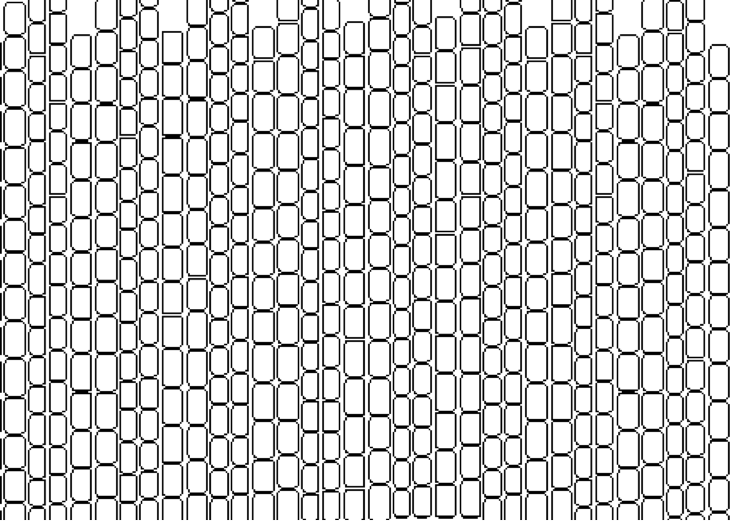 f. 2, Schematic plan of wall hung ceramic artworks Wall hung ceramic artworks consist of single ceramic plates hanging in a mosaic way. In this way, the artworks may extend both vertically and horizontally to infinity, so they no longer look like traditional wall hung couplets. Varying according to the height or curve of walls, they cover the walls like a huge piece of colorful ceramic cloth. These hard plates can be flexibly interwoven into a wall or a single ceramic art installation. This makes wide application of wall hung ceramic artworks possible. Please refer to Figure 2 for the schematic plan. 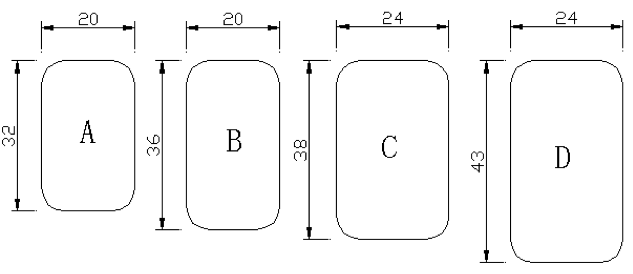 f. 3, Sizes for the front of a plate
These plates shall both have advantages like high plasticity, beautiful glaze colors and good light reflection, and avoid defects such as vulnerability. Therefore, each plate is shaped as a smooth oblong which has no right angle or sharp edge on five sides, front, upper, lower, left and right. Please refer to Figure 3 and 4 for its varied sizes and basic shapes. (Unit: centimeter) In order to meet technological requirements for hanging the artworks in fixed places and increasing intensity of the plates, reinforced supports are added to the back of the plates for the first time. Please refer to Figure 4.
|
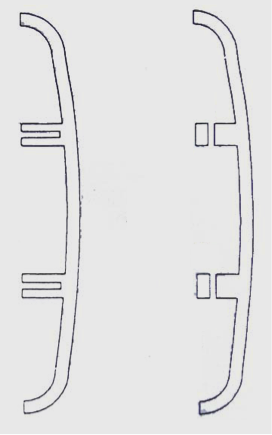 f. 4, Profile of single plates
Molding of single plates: after various molding methods, including slip casting and pressing, are tested, plastic pressing is chosen for production of the plates. In plastic pressing, clay water content ranges between 19% and 22%, air pressure remains no more than 0.5MPa and oil pressure no more than 6MPa. Single plates are made of well-chosen glazing materials with proper glazing and firing technologies, according to major quality and technological indexes. Except advantages of firmer quality and less vulnerability, plates made in this way achieve some unexpected artistic effects. First, they reflect colors from different directions. Their smooth glaze reflects highly distinctive natural colors. Second, artworks made of the plates look slightly different as viewers move, so viewers may feel they see different images. Third, ceramic artworks perform better than those made of other materials in terms of absorption of indoor sounds, which has been positively confirmed by application of Colorful Flying Wings at Shanghai Oriental Art Center. |
|
|
|
|
Metal elements for connecting ceramic plates and building walls Metal elements solve the problem of connecting ceramic plates and building. Generally, ceramic bricks are glued to walls with concrete or special adhesive. When installing wall hung ceramic artworks, however, we creatively employ the method of “suspended hanging”, which has been widely applied to wall decoration of modern buildings. That is, hung ceramic plates are connected and suspended from a wall with metal elements. Such a method is more complicated and expensive than that of using special adhesive. |
But there are obvious benefits for the plates to be hung in this way as a whole piece of art. First, they are secured tightly and lastingly. The method guarantees no partial rupture or even large-scale peeling caused by the reaction of the plates to different temperatures and moistures of the wall. Second, the distance between the plates and the wall makes it possible to add sound absorption and heat insulation layers to the wall. Third, it is easy to replace broken plates while leaving the whole artwork intact for artistic appreciation and viewing. Fourth, the artwork looks artistically prettier and closer to viewers.
|
|
|
|
|
The method The method is actualized by the use of seven components: 1. the guide for wire rope (Figure 5 and 6), used above and below the artwork to connect it with the load-bearing structure of the wall. 2. horizontal slide rail (Figure 5 and 6), used to regulate wire ropes horizontally and drag the ropes directly. 3. stainless steel rope, whose diameter is determined by the vertical height of the artwork provided safety is guaranteed. 4. prefixed part (Figure 5, 6 and 7), designed specifically and fixed to a proper part of the steel rope according to the size of plates. 5. adhesive part (Figure 7), glued to plates to fix the plates to designated places along the steel rope. 6. middle post for fixing wire rope (Figure 8). A steel post is used every height of a person so that the wire rope may keep parallel to the wall and shift the load generated by the weight of plates to the concrete wall section by section. |
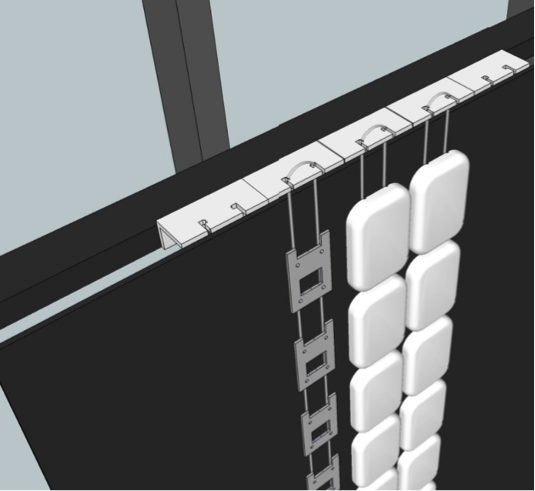 f.5, Upper part of wall hung ceramic artwork |
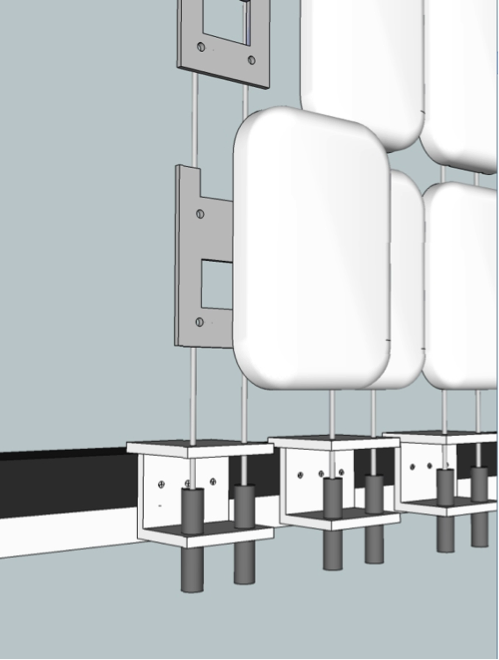 f.6, Lower part of wall hung ceramic artwork |
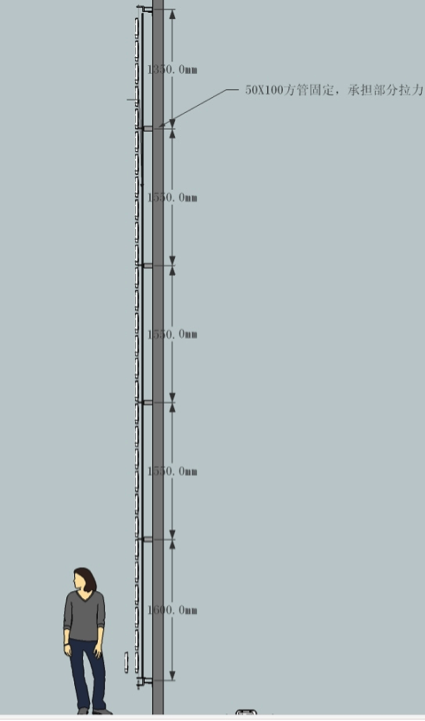 f.8, Middle post of wall hung ceramic artwork |
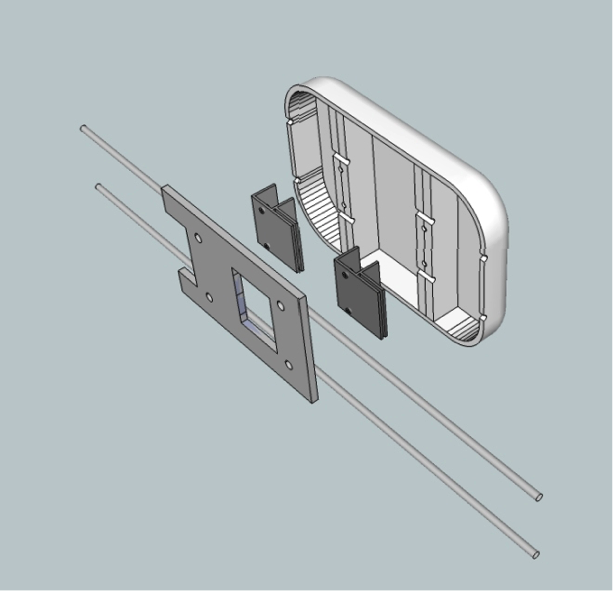 f.7, Single plate fixing structure |
|
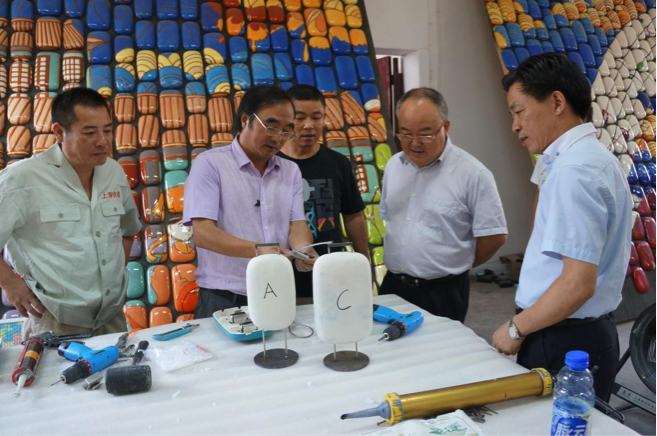 f.9, Jiang Xingguo briefs real estate owners about the technology connecting wall hung ceramic artwork to the wall |
|
|
The soul of ceramic art Creativity instills the soul of ceramic art into public buildings. Problems like design and production of single plates and connection between plates and walls have been effectively solved. This has thus opened a door wide for application of modern ceramic art in public buildings, and for landscape ceramic artists to bring their creative talent into play. Our motto for every wall hung ceramic artwork or other ceramic art installation, like murals and ceramic walls, in public architecture is: to instill the soul of art into public buildings. The soul comes from the idea of architecture, so it must fit in with regional culture, contemporary aesthetics and development trends while having broad space for imagination. Every wall hung ceramic artwork made in this way will be a integral part of buildings and an once-of-a-kind art-piece. Consequently, it is indispensable to collect, research on and ponder upon various cultural elements concerning place, time and the building after we are entrusted with a project. Take Colorful Flying Wings at Shanghai Oriental Art Center for example. |
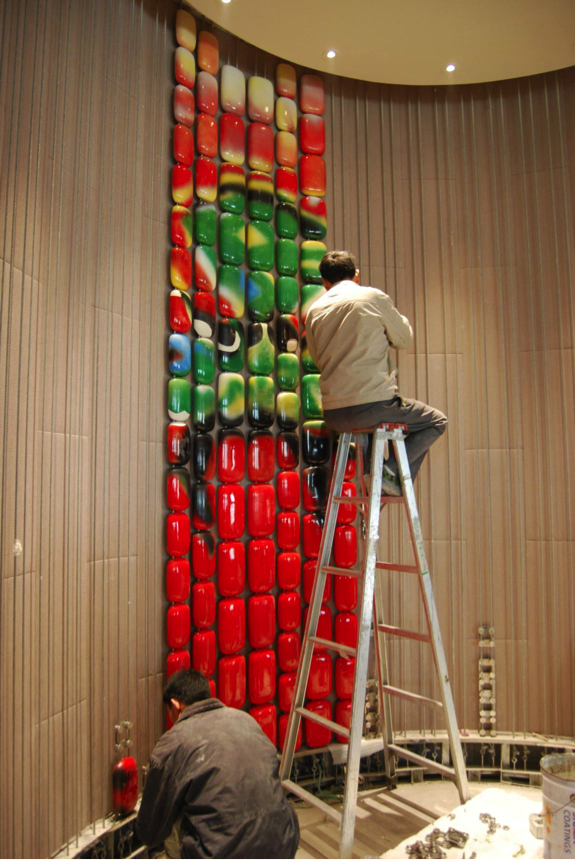 f.10, Installation of wall hung ceramic artwork |
MAKERS
Jiang Guoxing, Wayne Higby, Ole Lislerud, Ray Meeker, their contribution in architectural production.
(read more...)éditorial N°0
Academy is a place of discussion, exchange, and reflection to share knowledge.
(read more...)
